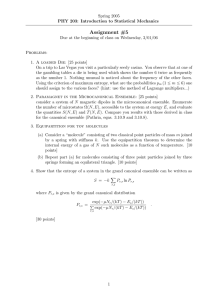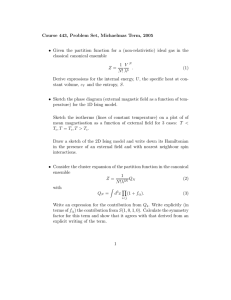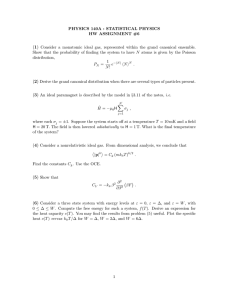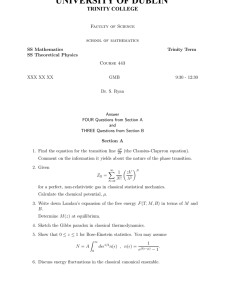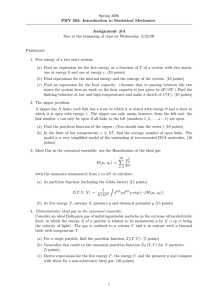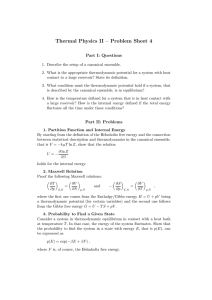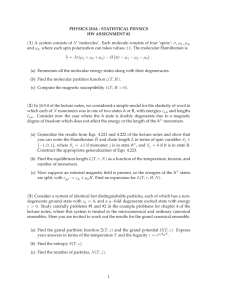Appendix C extra - Grand canonical ensemble Cx5 - 1
advertisement
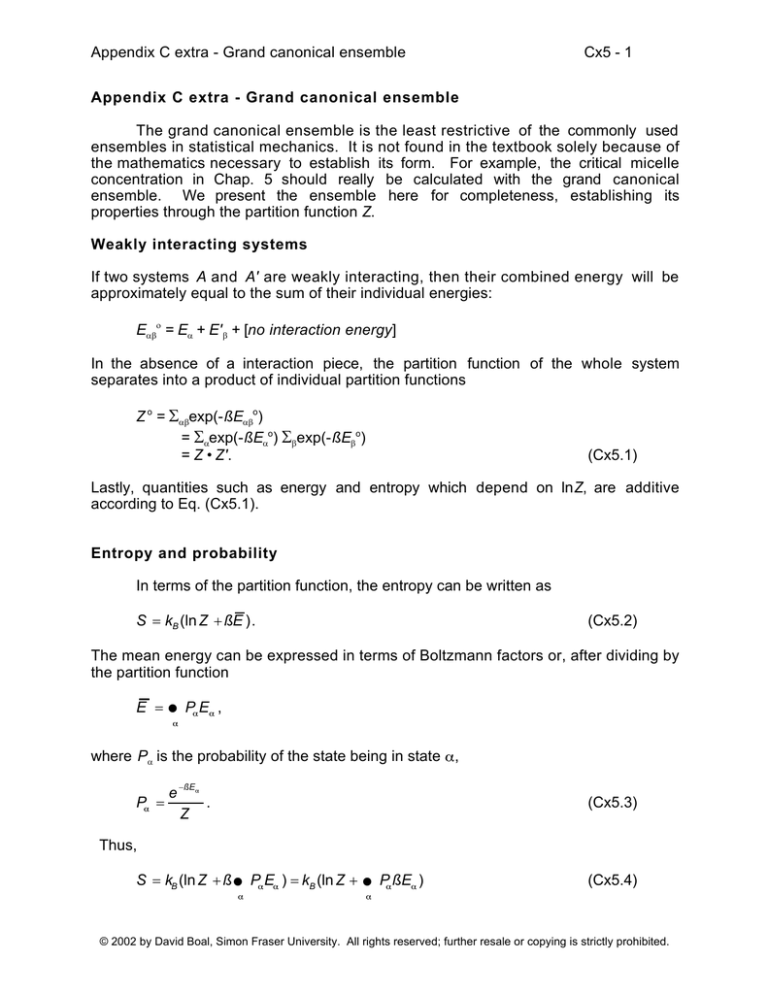
Appendix C extra - Grand canonical ensemble Cx5 - 1 Appendix C extra - Grand canonical ensemble The grand canonical ensemble is the least restrictive of the commonly used ensembles in statistical mechanics. It is not found in the textbook solely because of the mathematics necessary to establish its form. For example, the critical micelle concentration in Chap. 5 should really be calculated with the grand canonical ensemble. We present the ensemble here for completeness, establishing its properties through the partition function Z. Weakly interacting systems If two systems A and A' are weakly interacting, then their combined energy will be approximately equal to the sum of their individual energies: Eαβο = Eα + E' β + [no interaction energy] In the absence of a interaction piece, the partition function of the whole system separates into a product of individual partition functions Z o = Σαβexp(-ßEαβo) = Σαexp(-ßEαo) Σβexp(-ßEβo) = Z • Z'. (Cx5.1) Lastly, quantities such as energy and entropy which depend on lnZ, are additive according to Eq. (Cx5.1). Entropy and probability In terms of the partition function, the entropy can be written as S = kB (ln Z + ßE ). (Cx5.2) The mean energy can be expressed in terms of Boltzmann factors or, after dividing by the partition function E = ∑P E , where Pα is the probability of the state being in state , e −ßE P = . Z (Cx5.3) Thus, S = kB (ln Z + ß ∑ P E ) = kB (ln Z + ∑ P ßE ) (Cx5.4) © 2002 by David Boal, Simon Fraser University. All rights reserved; further resale or copying is strictly prohibited. Appendix C extra - Grand canonical ensemble Cx5 - 2 Now, Eq. (Cx5.4) can be rearranged to read ln(PαZ) = -ßEα which permits Eq. (Cx5.3) to be recast as S = kB ln Z − ∑ P ln(P Z ) = kB ln Z − ∑ P ln(P ) − ∑ P ln Z = kB ln Z − ∑ P lnP − ln Z ∑ P where the last line follows because lnZ is a constant. Now, the sum of the probabilities must equal unity, ΣαPα = 1, so S = kB ln Z − ∑ P lnP − ln Z or (Cx5.5) S = −kB ∑ P lnP Eq. (Cx5.5) is a very useful alternative to the definition of S in terms of the partition function or the number of accessible states: S = kB (ln Z + ßE ) or S = kBln . Grand canonical ensemble Although most of the systems we deal with can be described by the canonical ensemble (NVT or NPT), many situations of interest do not have fixed particle number N. Such systems are free to exchange particles with their surroundings. Consider, as usual, two systems A and A' which are allowed to come into contact via a porous wall, with no change in total volume: A A' © 2002 by David Boal, Simon Fraser University. All rights reserved; further resale or copying is strictly prohibited. Appendix C extra - Grand canonical ensemble Cx5 - 3 The presence of a porous wall, rather than a moveable piston, means that the systems cannot do work on each other (local PV has no meaning). What the system has is: energy exchange Eo = E + E' = constant particle exchange No = N + N' = constant → → common temperature common chemical potential. The "Bolzmann factor" for a chemical potential can be determined in the same way that the factor was determined for the canonical ensemble with a temperature. Imagine two systems A and A', where A' is not only a heat reservoir, but also a particle reservoir: A' A Eα Nα A particular "state" in A is now characterized by its energy Eα and particle number Nα. For every state (Eα ,Nα), there are ' states in reservoir A', where ' = (E o-Eα , N o-Nα). Hence, the probability of system A' having (Eα ,Nα) is P(Eα ,Nα) ∝ '(E o-Eα , N o-Nα). Next, we perform the usual expansion of ln ' around E o, N o, assuming Eα << E o Nα << N o. That is ln '(E o − E ,N o − N ) = ln '(E o ,N o ) + ln ' ln ' (−E ) + (−N )... (Cx5.6) E' N' where we have used ∆E' = -Eα ∆N' = -Nα Define ≡ ln ' E' ≡− ln ' N' © 2002 by David Boal, Simon Fraser University. All rights reserved; further resale or copying is strictly prohibited. Appendix C extra - Grand canonical ensemble Cx5 - 4 so that Eq. (Cx5.6) becomes '(E o − E ,N o − N ) = '(E o ,N o )e − E + N after exponentiating. Hence, the generalized Boltzmann factor is P ∝ e− E + N (Cx5.7) Averages can be constructed from this weighting as usual: − E + E ∑E e = ∑e − E + N ∑N e = ∑e − E + − E + N N N N where the sums are unrestricted, since essentially all Eα , Nα combinations are accessible from the reservoir. © 2002 by David Boal, Simon Fraser University. All rights reserved; further resale or copying is strictly prohibited.
